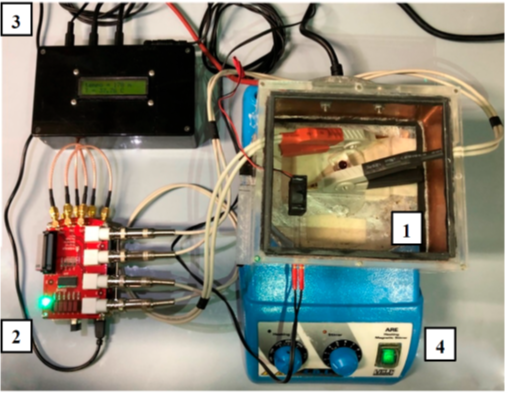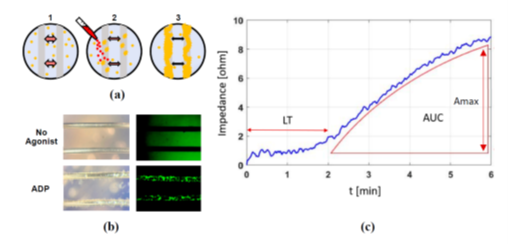MICELI: A Point-of-Care Impedance Platelet Aggregometer Prototype
-
Posted by
 Red Pitaya Team
, February 17, 2022
Red Pitaya Team
, February 17, 2022

In our day-to-day lives, we see how smaller devices become ever more powerful and reliable. What may be less obvious is that a similar evolution is also taking place in the medical world. The bulky instruments we often think of when it comes to hospital labs are getting more and more competition from smaller tools with similar or even higher performance levels. For Red Pitaya fans, discovering a STEMlab unit inside one of these devices should not be a surprise. In their article The MICELI (MICrofluidic, ELectrical, Impedance): Prototyping a Point-of-Care Impedance Platelet Aggregometer, Y. Roka-Moiia et al. provide an example of this development. Their work describes how blood platelets, critical cells for the maintenance of vascular integrity and tissue repair, can become activated in many diseases and result in pathologic thrombosis, or blood clots, which are potentially life-threatening.
This inadvertent blood coagulation can be avoided rather easily, using antithrombotic medication. Unfortunately, the efficacy of these drugs can be extremely patient-dependent, which can be particularly problematic for patients requiring emergency surgery, where platelet activation plays an important role, since there are no agents able to reverse the antiplatelet effect of the antithrombotic drugs. This makes careful monitoring of the platelet function at the PoC (Point-of-Care) extremely important when trying to avoid procedure-related bleeding, but very often medical staff need to rely on a traditional platelet count and coagulation test for bleeding risk assessment, since dedicated equipment is not available onsite.
The gold standard for platelet function monitoring is platelet aggregometry. Besides the LTA (Light Transmission Aggregometer) models, which are expensive and slow (processing time > 1h), and where the relatively large (6-10 ml) blood samples need to be pre-treated, there are also the Electrical Impedance Aggregometers (EIA). These instruments measure the increased impedance of induced platelet aggregation of whole blood over time, leading to faster results, but where the traditional, semiautomatic models are still rather expensive, and operators need specific training.
The main objective of the MICELI development was to deal with some of the biggest obstacles in the use of impedance aggregometers, by providing a portable, accurate and easy-to-use instrument, able to convert impedance data from smaller blood samples into aggregate values in a shorter time. In the prototype phase, this was done with the experimental setup which can be seen in Fig. 1. It includes a single-well cartridge with two horizontal silver electrodes inside a 37 °C thermostatic chamber (1); a Red Pitaya STEMlab 125-14, working as impedance analyzer (2), a temperature controller for the thermostatic chamber (3) and a magnetic stirrer (4).
 Figure 1
Figure 1
Figure 2 below shows how, after the addition of an agonist and an initial “lag time” LT, the blood sample’s activated platelets aggregate on the silver electrodes, leading to increased impedance. The “area-under-curve”, AUC, is then a quantitative indication of platelet activation.
 Figure 2
Figure 2
Multiple test runs were performed using this experimental setup on blood samples from 42 donors, for the optimization of the blood test volume, of the anticoagulant agent to maximize sample storage time, and of the agonist agent to reduce measuring time. Afterwards, accuracy and reproducibility tests were also carried out by performing identical tests on a commercial EIA model, the Multiplate® Analyzer.
The results show that the MICELI prototype provides optimum results with 250 ml sample volumes. Adding hirudin as anticoagulant leads to the longest sample storage time, but still means the test should ideally be performed within two hours after the blood is extracted. Agonist optimization shows that calcium ionophore generates the quickest platelet aggregation results, delivering results in less than 10 minutes. The comparative test with the Multiplate® Analyzer demonstrates that the MICELI prototype is able to guarantee good correlation with respect to platelet aggregation, interdonor distribution and sensitivity. This means that the functionality of the process – with the Red Pitaya STEMlab at its very centre for precise impedance measurement – has been demonstrated and that it mainly needs some minor finetuning and certification before the components can be assembled into a fully operational field unit.
Article: The MICELI (MICrofluidic, ELectrical, Impedance): Prototyping a Point-of-Care Impedance Platelet Aggregometer
Full text available here: https://www.mdpi.com/1422-0067/21/4/1174
Yana Roka-Moiia, Silvia Bozzi, Chiara Ferrari, Gabriele Mantica, Annalisa Dimasi, Marco Rasponi, Andrea Santoleri, Mariangela Scavone, Filippo Consolo, Marco Cattaneo, Marvin J. Slepian and Alberto Redaelli
About the Red Pitaya Team
The Red Pitaya editorial team consists of engineers, researchers, and product experts who develop and test cutting-edge open-source test & measurement solutions.
Our mission is to make advanced instrumentation accessible to everyone — from students and educators to leading research labs worldwide.



